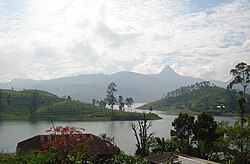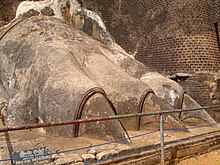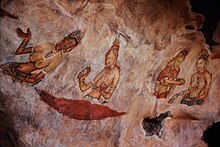Sigiriya or
Sinhagiri (
Lion Rock Sinhalese:
සීගිරිය,
Tamil:
சிகிரியா, pronounced see-gi-ri-yə) is an ancient rock
fortress located in the northern
Matale District near the town of
Dambulla in the
Central Province,
Sri Lanka.
The name refers to a site of historical and archaeological significance
that is dominated by a massive column of rock nearly 200 metres
(660 ft) high. According to the ancient Sri Lankan chronicle the
Culavamsa, this site was selected by King
Kasyapa
(477 – 495 CE) for his new capital. He built his palace on the top of
this rock and decorated its sides with colourful frescoes. On a small
plateau about halfway up the side of this rock he built a gateway in the
form of an enormous lion. The name of this place is derived from this
structure —Sīhāgiri, the Lion Rock. The capital and the royal palace was
abandoned after the king's death. It was used as a Buddhist monastery
until the 14th century.
[1]
Sigiriya today is a UNESCO listed
World Heritage Site. It is one of the best preserved examples of ancient urban planning.
[2]
The History
Legendary Past
Lal
Sirinivas and Mirando Obesekara described Sigiriya as a post historical
archeology turning point of Ravana. According to them, Sigiriya may be
the Alakamandava (the City of the Gods) that was built up before 50
centuries ago by King Kubera who was the half-brother of Ravana (Ravan)
as described in the Ramayanaya.
According to the Palm Leaf Book (Puskola Potha) of Ravana Watha (About
Ravana) the architect of the Sigiriya was a person called
Maya Danava.
He built up Sigiriya on the instructions given by King Visthavasa
(Vesamuni) the father of Ravana. During that period the Sigiriya was
called Alakamandava and during the period of King
Kuwera it was called
Cithranakuta. After the death of Ravana,
Vibeeshana
became the king and he shifted the kingdom to Kelaniya. As per this
book, Chiththaraja had used Alakamandava as his residence. Chiththaraja
was a relation of Vibeeshana and a Patrician of Yakka. It was also
stated that Chiththaraja was one of a persons who helped Prince
Pandukabhaya to get the kingship. Parents of Pandukabhaya were descended
from the tribe of Chiththaraja.
In addition, Ravana Watha was also described that Prince Kassapa who
was the son of King Daathusena has selected the Chithrakuta as his
residence due to the fact that her mother was a follower of Yakka belief
and also she descended from them. King Kassapa was the only king who
did reconstruction and maintained the Chiththakuta as done by the king
Ravana. The famous wall paintings in the Chiththakuta ( Later Sigiriya )
can be treated as displaying about the Sinhala Land i.e. Sri Lanka. The
Ravana Watha explains that the picture of blue coloured lady represents
the Yakka Tribe and other ladies represent the Tribes of Naga (Cobra),
Deva (Divine) and Gandabhbha (Odors) and the beautiful flowers show the
unity of the country.
[3]
Historical Past
The
environment around the Sigiriya may have been inhabited since
prehistoric times. There is clear evidence that the many rock shelters
and caves in the vicinity were occupied by Buddhist monks and ascetics
from as early as the 3rd century BCE. The earliest evidence of human
habitation at Sigiriya is the Aligala rock shelter to the east of
Sigiriya rock, indicating that the area was occupied nearly five
thousand years ago during the
Mesolithic Period.
Buddhist monastic settlements were established during the 3rd century
BCE in the western and northern slopes of the boulder-strewn hills
surrounding the Sigiriya rock. Several rock shelters or caves were
created during this period. These shelters were made under large
boulders, with carved drip ledges around the cave mouths.
Rock inscriptions
are carved near the drip ledges on many of the shelters, recording the
donation of the shelters to the Buddhist monastic order as residences.
These were made in the period between the 3rd century BCE and the 1st
century CE.
In 477 CE, Kashyapa, the king’s son by a non-royal consort, seized the throne from King
Dhatusena, following a coup assisted by Migara, the King’s nephew and army commander. The rightful heir,
Moggallana, fearing for his life, fled to
South India. Afraid of an attack by Moggallana, Kashyapa moved the capital and his residence from the traditional capital of
Anuradhapura
to the more secure Sigiriya. During King Kashyapa’s reign (477 to 495
CE), Sigiriya was developed into a complex city and fortress.
[1][2]
Most of the elaborate constructions on the rock summit and around it,
including defensive structures, palaces, and gardens, date from this
period.
The
Culavamsa describes King Kashyapa as the son of King
Dhatusena.
Kashyapa murdered his father by walling him up alive and then usurping
the throne which rightfully belonged to his half-brother Moggallana,
Dhatusena's son by the true queen. Moggallana fled to
India
to escape being assassinated by Kashyapa, but vowed revenge. In India
he raised an army with the intention of returning and retaking the
throne of Sri Lanka, which he considered to be rightfully his. Expecting
the inevitable return of Moggallana, Kashyapa is said to have built his
palace on the summit of Sigiriya as a fortress as well as a pleasure
palace. Moggallana finally arrived, declared war, and defeated Kashyapa
in 495 CE. During the battle Kashyapa's armies abandoned him and he
committed suicide by falling on his sword.
The Culavamsa and folklore inform us that the battle-elephant on
which Kashyapa was mounted changed course to take a strategic advantage,
but the army misinterpreted the movement as the king's having opted to
retreat, prompting the army to abandon him altogether. It is said that
being too proud to surrender he took his dagger from his waistband, cut
his throat, raised the dagger proudly, sheathed it, and fell dead.
Moggallana returned the capital to Anuradhapura, converting Sigiriya
into a Buddhist monastery complex,
[4]
which survived until the 13th or 14th century. After this period, no
records are found on Sigiriya until the 16th and 17th centuries, when it
was used briefly as an outpost of the
Kingdom of Kandy.
Alternative stories have the primary builder of Sigiriya as King
Dhatusena, with Kashyapa finishing the work in honour of his father.
Still other stories describe Kashyapa as a playboy king, with Sigiriya
his pleasure palace. Even Kashyapa's eventual fate is uncertain. In some
versions he is assassinated by poison administered by a concubine; in
others he cuts his own throat when deserted in his final battle.
[5]
Still further interpretations regard the site as the work of a Buddhist
community, without a military function. This site may have been
important in the competition between the
Mahayana and
Theravada Buddhist traditions in ancient Sri Lanka.
Archaeological remains and features
The Lion Gate and Climbing Stretch
In 1831 Major Jonathan Forbes of the 78th Highlanders of the British
army, while returning on horseback from a trip to Pollonnuruwa,
encountered the "bush covered summit of Sigiriya".
[6]
Sigiriya came to the attention of antiquarians and, later,
archaeologists. Archaeological work at Sigiriya began on a small scale
in the 1890s. H.C.P. Bell was the first archaeologist to conduct
extensive research on Sigiriya. The Cultural Triangle Project, launched
by the
Government of Sri Lanka,
focused its attention on Sigiriya in 1982. Archaeological work began on
the entire city for the first time under this project. There was a
sculpted lion's head above the legs and paws flanking the entrance, but
the head collapsed years ago.
Sigiriya consists of an ancient citadel built by King Kashyapa during
the 5th century. The Sigiriya site contains the ruins of an upper
palace located on the flat top of the rock, a mid-level terrace that
includes the Lion Gate and the mirror wall with its frescoes, the lower
palaces located behind the lavish lower gardens, and moats and ramparts
which protected the citadel. The site was both a palace and a fortress.
The upper palace on the top of the rock includes cisterns cut into the
rock.
Close up of the Lion's Paw
Site plan
Sigiriya is considered to be one of the most important urban planning sites of the first millennium, and the
site plan
is considered very elaborate and imaginative. The plan combined
concepts of symmetry and asymmetry to intentionally interlock the
man-made geometrical and natural forms of the surroundings. On the west
side of the rock lies a park for the royals, laid out on a symmetrical
plan; the park contains water-retaining structures, including
sophisticated surface/subsurface hydraulic systems, some of which are
working today. The south contains a man-made reservoir; these were
extensively used from the previous capital of the dry zone of Sri Lanka.
Five gates were placed at entrances. The more elaborate western gate is
thought to have been reserved for the royals.
[7][8]
Frescoes
John Still
in 1907 suggested, "The whole face of the hill appears to have been a
gigantic picture gallery... the largest picture in the world perhaps".
[9]
The paintings would have covered most of the western face of the rock,
an area 140 metres long and 40 metres high. There are references in the
graffiti to 500 ladies in these paintings. However, most have been lost
forever. More frescoes, different from those on the rock face, can be
seen elsewhere, for example on the ceiling of the location called the
"Cobra Hood Cave".
Although the frescoes are classified as in the
Anuradhapura period, the painting style is considered unique;
[10]
the line and style of application of the paintings differing from
Anuradhapura paintings. The lines are painted in a form which enhances
the sense of volume of the figures. The paint has been applied in
sweeping strokes, using more pressure on one side, giving the effect of a
deeper colour tone towards the edge. Other paintings of the
Anuradhapura period contain similar approaches to painting, but do not
have the sketchy lines of the Sigiriya style, having a distinct artists'
boundary line. The true identity of the ladies in these paintings still
have not been confirmed. There are various ideas about their identity.
Some believe that they are the ladies of the king's while others think
that they are women taking part in religious observances. These pictures
have a close resemblance to paintings seen in the
Ajanta caves in
India.
Mirror wall
The mirror wall and spiral stairs leading to the frescoes
Originally this wall was so highly polished that the king could see
himself whilst he walked alongside it. Made of brick masonry and covered
in highly polished white plaster,
[11]
the wall is now partially covered with verses scribbled by visitors,
some of them dating from as early as the 8th century. People of all
types wrote on the wall, on varying subjects such as love, irony, and
experiences of all sorts. Further writing on the mirror wall now has
been banned for the protection of the old writings.
The
Archaeological Commissioner of Ceylon,
Senarath Paranavithana, deciphered 685 verses written in the 8th, 9th and 10th centuries CE on the mirror wall.
[12] One such poem from these long-past centuries, roughly translated from Sinhala, is:
[13]
"I am Budal [the writer's name]. Came with hundreds of people to see Sigiriya. Since all the others wrote poems, I did not!"
Gardens
The
Gardens of the Sigiriya city are one of the most important aspects of
the site, as it is among the oldest landscaped gardens in the world. The
gardens are divided into three distinct but linked forms: water
gardens, cave and boulder gardens, and terraced gardens.
Water gardens
A pool in the garden complex
The water gardens can be seen in the central section of the western
precinct. Three principal gardens are found here. The first garden
consists of a plot surrounded by water. It is connected to the main
precinct using four causeways, with gateways placed at the head of each
causeway. This garden is built according to an ancient garden form known
as
char bagh, and is one of the oldest surviving models of this form.
The second contains two long, deep pools set on either side of the
path. Two shallow, serpentine streams lead to these pools. Fountains
made of circular limestone plates are placed here. Underground water
conduits supply water to these fountains which are still functional,
especially during the rainy season. Two large islands are located on
either side of the second water garden. Summer palaces are built on the
flattened surfaces of these islands. Two more islands are located
farther to the north and the south. These islands are built in a manner
similar to the island in the first water garden.
The gardens of Sigiriya, as seen from the summit of the Sigiriya rock
The third garden is situated on a higher level than the other two. It
contains a large, octagonal pool with a raised podium on its northeast
corner. The large brick and stone wall of the citadel is on the eastern
edge of this garden.
The water gardens are built symmetrically on an east-west axis. They
are connected with the outer moat on the west and the large artificial
lake to the south of the Sigiriya rock. All the pools are also
interlinked using an underground conduit network fed by the lake, and
connected to the moats. A miniature water garden is located to the west
of the first water garden, consisting of several small pools and
watercourses. This recently discovered smaller garden appears to have
been built after the Kashyapan period, possibly between the 10th and
13th centuries.
Boulder gardens
The
boulder gardens consist of several large boulders linked by winding
pathways. The gardens extend from the northern slopes to the southern
slopes of the hills at the foot of Sigiris rock. Most of these boulders
had a building or pavilion upon them; there are cuttings that were used
as footings for brick walls and beams.They were used to be pushed off
from the top to attack enemies when they approached.
Terraced gardens
The
terraced gardens are formed from the natural hill at the base of the
Sigiriya rock. A series of terraces rises from the pathways of the
boulder garden to the staircases on the rock. These have been created by
the construction of brick walls, and are located in a roughly
concentric plan around the rock. The path through the terraced gardens
is formed by a limestone staircase. From this staircase, there is a
covered path on the side of the rock, leading to the uppermost terrace
where the lion staircase is situated.











